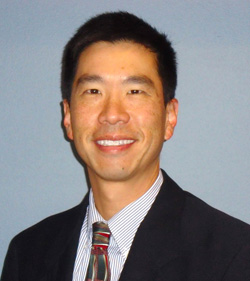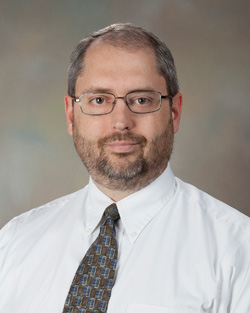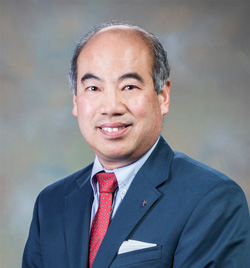ALBUQUERQUE, N.M. — Fellows of the American Society of Mechanical Engineers make up only 3.1 percent of ASME’s 107,895 members. Sandia National Laboratories engineers Cliff Ho, Alexander Brown, Hy Tran and Kevin Dowding now are members of that elite group.
Election as a fellow “recognizes exceptional engineering achievements and contributions to the engineering profession,” according to the organization.
Sandia Labs’ new fellows have diverse backgrounds in science and engineering:
- Cliff Ho has led innovations in solar energy, water treatment and nuclear waste management;
- Alexander Brown conducted safety assessments for the Mars Science Laboratory rover;
- Hy Tran works in the Primary Standards Laboratory to develop and maintain precise measurement standards for nuclear weapons components; and
- Kevin Dowding has developed advanced standards for computational modeling in nuclear weapon design.
Cliff Ho: innovating in solar, water and environmental research
Ho recently led a team that developed the world’s first high-temperature falling particle receiver system for concentrating solar power. Ho’s work helped improve concentrating solar power performance and capabilities while lowering the cost of the large-scale source of clean energy. His falling particle receiver won an R&D 100 award in 2016. He won another R&D 100 award earlier in his career for a tool that mitigates hazardous glare from solar panels and was adopted by the Federal Aviation Administration and Department of Defense to improve safety near airports and military sites.

Sandia National Laboratories researcher Cliff Ho has been named a fellow of the American Society of Mechanical Engineers. Ho has led innovations in solar energy, water treatment and nuclear waste management. (Photo courtesy of Sandia National Laboratories) Click on the thumbnail for a high-resolution image.
Ho led several water programs sponsored by the Department of Energy and the Environmental Protection Agency to ensure safe and sustainable water supplies, including the U.S. Central Regional Workshop to examine the energy-water nexus. Ho led research in water treatment and distribution security, including ultraviolet disinfection and modeling to predict how contaminants would move through water distribution networks, and developed microchemical sensors to monitor environmental contaminants in wells. Ho also led a large project to develop modeling for subsurface heat and fluid flow for nuclear waste management, and his approach has been broadly used for a variety of energy and environmental applications.
Ho received his master’s degree and doctorate in mechanical engineering from the University of California, Berkeley, and his bachelor’s degree from the University of Wisconsin. He received the National Asian American Engineer of the Year award in 2010, holds 10 patents, has published two books and serves as associate editor for the Solar Energy Journal. He was an adjunct professor at the University of New Mexico from 1996 to 2003 and received the university’s Outstanding Professor Award in 1997.
Alexander Brown: researching and assessing fire

Sandia National Laboratories researcher Alexander Brown has conducted safety assessments for the Mars Science Laboratory rover. Brown was named a fellow of the American Society of Mechanical Engineers. (Photo courtesy of Sandia National Laboratories) Click on the thumbnail for a high-resolution image.
Brown researches and assesses fire and its impact on systems in the Engineering Sciences Center. His improvements in code and model development, simulation analysis and experimental testing allowed him to make significant contributions to the understanding of fire and basic energy technologies. His work is credited with contributing to the approval for the launch of the Mars Science Laboratory rover in 2011, so its special nuclear material power sources could go into space. He has served the Nuclear Regulatory Commission as an expert reviewer for nuclear power plant fire assessments for the past decade. He also has done experiments and modeling to determine how liquids react when they meet another surface, studying the breakup of the liquid upon impact. Brown has made novel contributions to programs relating to the dispersal, reaction and transport of atmospheric plumes.
Brown received his doctorate in mechanical engineering from the University of Colorado at Boulder. While in Boulder, he had student research appointments at the National Center for Atmospheric Research in the Applied Technologies Division and at the National Renewable Energy Laboratory in the National Bioenergy Center. He has served in leadership roles within ASME’s Heat Transfer Division for six years and is an associate editor for the Journal of Thermal Science and Engineering Applications.

Sandia National Laboratories researcher Hy Tran, who has been named a fellow of the American Society of Mechanical Engineers, works in Sandia Labs’ Primary Standards Laboratory. (Photo courtesy of Sandia National Laboratories) Click on the thumbnail for a high-resolution image.
Hy Tran: calibrating with nanoscale accuracy
Tran provides technical leadership for all dimensional, force and mass measurement science (metrology) with the Department of Energy and National Nuclear Security Administration enterprise. He has improved the accuracy of high fidelity measurements and standards needed for high-reliability nuclear weapons components through innovative statistical modeling. He has expanded the research done at the Primary Standards Laboratory, and his leadership in measurement science outreach and education through professional organizations has helped expand ASME’s role in metrology.
Tran won an R&D 100 award for a three-dimensional micro-machined calibration reference standard that improves measurement accuracy in Mesoscale Measurement Machines used for high-volume parts manufacturing. His calibration reference standard is 10 times more accurate and less expensive than its predecessor, and can be used in the manufacture of miniaturized devices such as fuel injectors, watch components and inkjet printers.
Tran received his doctorate and master’s degree in mechanical engineering from Stanford University, and holds bachelor’s degrees in life sciences and mechanical engineering from MIT. He performs educational outreach through Accreditation Board for Engineering and Technology accreditation efforts and serves as vice president for

Sandia National Laboratories researcher Kevin Dowding was named an American Society of Mechanical Engineers fellow. He developed advanced standards for computational modeling in nuclear weapon design. (Photo courtesy of Sandia National Laboratories) Click on the thumbnail for a high-resolution image.
learning and development for the National Conference of Standards Laboratories International.
Kevin Dowding: computational modeling for national security
Dowding has made significant technical and leadership contributions to national security by developing computational modeling for nuclear weapon design. He has served as the technical lead to integrate computational modeling for the design and qualification of Sandia’s B61 life extension program and pioneered computational approaches for understanding and measuring margins and uncertainty in abnormal thermal environments.
Dowding is a founding member and co-author of the verification and validation standard released by the ASME Committee for Verification and Validation of Computational Fluid Dynamics and Heat Transfer. He has been a reviewer for more than 10 journals and the National Science Foundation. He earned his bachelor’s, master’s and doctorate degrees in mechanical engineering from Michigan State University.
Sandia National Laboratories is a multimission laboratory operated by National Technology and Engineering Solutions of Sandia LLC, a wholly owned subsidiary of Honeywell International Inc., for the U.S. Department of Energy’s National Nuclear Security Administration. Sandia Labs has major research and development responsibilities in nuclear deterrence, global security, defense, energy technologies and economic competitiveness, with main facilities in Albuquerque, New Mexico, and Livermore, California.
Sandia news media contact: Kristen Meub, klmeub@sandia.gov, (505) 845-7215